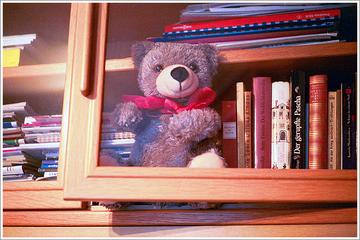“…(…) There arose a universal consciousness of history that extended even to people in those strata of society who had previously lived a life of magic - the peasants - who [with the introduction of cheap printing and a universal education in the 19th Century] began to live a proletarian, historical life. This took place thanks to cheap texts: Books, newspapers, flyers, all kinds of texts became cheap and resulted in a historical consciousness that was equally cheap and a conceptual thinking that was equally cheap - leading to two diametrically opposite developments. On one hand, traditional images finding refuge from the inflation of texts in ghettos, such as museums, salons and galleries, became hermetic (universally undecodable) and lost their influence on daily life. On the other hand, there came into being hermetic texts aimed at the specialist élite, i.e. a scientific literature with which cheap kind of conceptual thinking was not competent to deal. Thus culture divided into three branches: that of the fine arts fed with traditional images which were, however, conceptually and technically enriched; that of science and technology fed with hermetic texts; and that of broad strata of society fed with cheap texts. To prevent culture breaking up, technical images were invented - as a code that was to be valid for the whole society.” Flusser in “Towards a philosophy of Photography” (Für eine Philosophie der Fotografie.), pages 18ff, Reaction Books ISBN 1 86189 076 1.
“Technical Images” are images created by machines, of course, many are camera generated photographs, the images that work as a very nice “glue” across groups of culture feeding on various accessible (popular) or less accessible (hermetic) texts… complex cultural ideas feed photography as successfully as science as successfully as political messages as successfully as low end down dirty gossip (though often there is no strong distinction betwen some of them, of course). Photography is the universally accepted way of objective visual communication.
Flusser continues: “…technical images were to introduce images back into daily life; second they were to make hermetic texts comprehensible; and third, they were to make visible the subliminal magic that was continuing to operate in cheap texts. They were to form the lowest common denominator for art, science and politics (in the sense of universal values), i.e. to be at one at the same time ‘beautiful’, ‘true’ and ‘good’, and in this way, as a universally valid code, they were to overcome the crisis of culture - of art, science and politics.”
Yet, photography is not only cheap to produce, it is becoming cheaper and faster to produce. It is becoming more and more accessible, thus saturating more and more all of the branches of culture. Photographs are the perfect filler, the perfect validating document, the perfect illustration, the perfect memory builder, because they appear to be so similar to what we perceive as our reality. They give us the illusion to be carriers of that thing called “truth.” This is, of course, an incredibly tempting quality about them.
“Technical images absorb the whole of history and form a collective memory going endlessly round in circles.
Nothing can resist the force of this current of technical images - there is no artistic, scientific or political activity which is not aimed at it, there is no everyday activity which does not aspire to be photographed, filmed, videotaped. For there is a general desire to be endlessly remembered and endlessly repeatable. All events are nowadays aimed at the television screen, the cinema screen, the photograph, in order to be translated into a state of things.”
How long will it take for us to realize that what we perceive as the magic of truth carried on the surfaces of photographs is as much of a subjective creation as many other forms of human expression.
How long will it take us to realize that photographs as well are very highly manipulated messengers of a point of view of a person or a group?
And to maybe try to ask this question in a different way: are we as fascinated by the magic of photographs as our ancestors were by the paintings and sculptures in (the trusted environment of) tempels?
Are we turning into not just consumers but worshippers of technical images? Will the future be decided by those who can speak to us with more “truthful” and more powerful visual confirmations of their actions?
Or are at this stage already? Are we far beyond?
What does this all have to do with the strange title of this entry? (Or is the title not strange at all?)
Now let's read this... : )
Posted by: Witold Riedel on February 16, 2004 10:17 PMBecause a pictures worth a thousand words people have become a lot less eloquent then they used to be
Posted by: Boreese on February 17, 2004 11:11 AMwow, i really love this article.
it is exactly what i am busy with...
writing a work for my postgraduate (i am graduating this year in Bezalel Tel Aviv) and it is ALL about this.
great source of information.
check this
might be interesting for you too.
